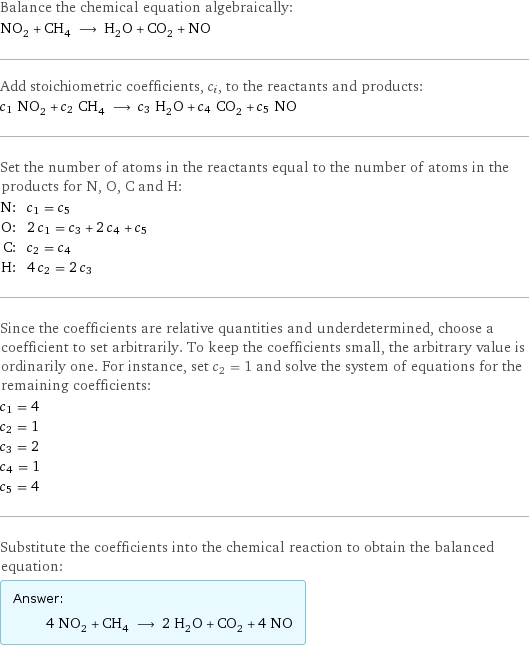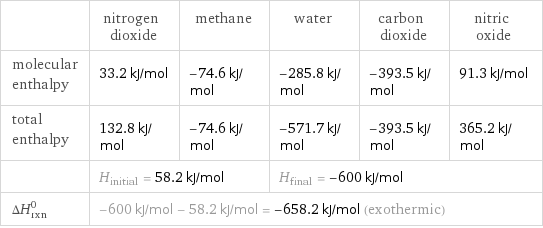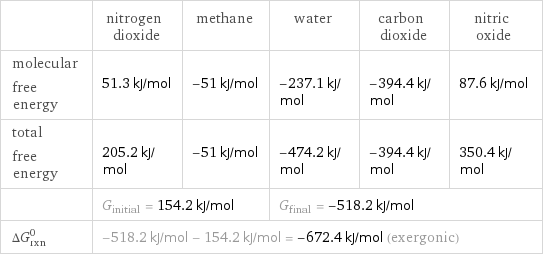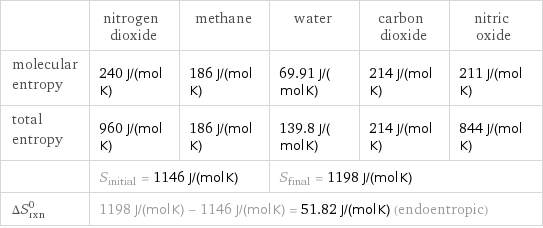Input interpretation

NO_2 nitrogen dioxide + CH_4 methane ⟶ H_2O water + CO_2 carbon dioxide + NO nitric oxide
Balanced equation

Balance the chemical equation algebraically: NO_2 + CH_4 ⟶ H_2O + CO_2 + NO Add stoichiometric coefficients, c_i, to the reactants and products: c_1 NO_2 + c_2 CH_4 ⟶ c_3 H_2O + c_4 CO_2 + c_5 NO Set the number of atoms in the reactants equal to the number of atoms in the products for N, O, C and H: N: | c_1 = c_5 O: | 2 c_1 = c_3 + 2 c_4 + c_5 C: | c_2 = c_4 H: | 4 c_2 = 2 c_3 Since the coefficients are relative quantities and underdetermined, choose a coefficient to set arbitrarily. To keep the coefficients small, the arbitrary value is ordinarily one. For instance, set c_2 = 1 and solve the system of equations for the remaining coefficients: c_1 = 4 c_2 = 1 c_3 = 2 c_4 = 1 c_5 = 4 Substitute the coefficients into the chemical reaction to obtain the balanced equation: Answer: | | 4 NO_2 + CH_4 ⟶ 2 H_2O + CO_2 + 4 NO
Structures

+ ⟶ + +
Names

nitrogen dioxide + methane ⟶ water + carbon dioxide + nitric oxide
Reaction thermodynamics
Enthalpy

| nitrogen dioxide | methane | water | carbon dioxide | nitric oxide molecular enthalpy | 33.2 kJ/mol | -74.6 kJ/mol | -285.8 kJ/mol | -393.5 kJ/mol | 91.3 kJ/mol total enthalpy | 132.8 kJ/mol | -74.6 kJ/mol | -571.7 kJ/mol | -393.5 kJ/mol | 365.2 kJ/mol | H_initial = 58.2 kJ/mol | | H_final = -600 kJ/mol | | ΔH_rxn^0 | -600 kJ/mol - 58.2 kJ/mol = -658.2 kJ/mol (exothermic) | | | |
Gibbs free energy

| nitrogen dioxide | methane | water | carbon dioxide | nitric oxide molecular free energy | 51.3 kJ/mol | -51 kJ/mol | -237.1 kJ/mol | -394.4 kJ/mol | 87.6 kJ/mol total free energy | 205.2 kJ/mol | -51 kJ/mol | -474.2 kJ/mol | -394.4 kJ/mol | 350.4 kJ/mol | G_initial = 154.2 kJ/mol | | G_final = -518.2 kJ/mol | | ΔG_rxn^0 | -518.2 kJ/mol - 154.2 kJ/mol = -672.4 kJ/mol (exergonic) | | | |
Entropy

| nitrogen dioxide | methane | water | carbon dioxide | nitric oxide molecular entropy | 240 J/(mol K) | 186 J/(mol K) | 69.91 J/(mol K) | 214 J/(mol K) | 211 J/(mol K) total entropy | 960 J/(mol K) | 186 J/(mol K) | 139.8 J/(mol K) | 214 J/(mol K) | 844 J/(mol K) | S_initial = 1146 J/(mol K) | | S_final = 1198 J/(mol K) | | ΔS_rxn^0 | 1198 J/(mol K) - 1146 J/(mol K) = 51.82 J/(mol K) (endoentropic) | | | |
Equilibrium constant
![Construct the equilibrium constant, K, expression for: NO_2 + CH_4 ⟶ H_2O + CO_2 + NO Plan: • Balance the chemical equation. • Determine the stoichiometric numbers. • Assemble the activity expression for each chemical species. • Use the activity expressions to build the equilibrium constant expression. Write the balanced chemical equation: 4 NO_2 + CH_4 ⟶ 2 H_2O + CO_2 + 4 NO Assign stoichiometric numbers, ν_i, using the stoichiometric coefficients, c_i, from the balanced chemical equation in the following manner: ν_i = -c_i for reactants and ν_i = c_i for products: chemical species | c_i | ν_i NO_2 | 4 | -4 CH_4 | 1 | -1 H_2O | 2 | 2 CO_2 | 1 | 1 NO | 4 | 4 Assemble the activity expressions accounting for the state of matter and ν_i: chemical species | c_i | ν_i | activity expression NO_2 | 4 | -4 | ([NO2])^(-4) CH_4 | 1 | -1 | ([CH4])^(-1) H_2O | 2 | 2 | ([H2O])^2 CO_2 | 1 | 1 | [CO2] NO | 4 | 4 | ([NO])^4 The equilibrium constant symbol in the concentration basis is: K_c Mulitply the activity expressions to arrive at the K_c expression: Answer: | | K_c = ([NO2])^(-4) ([CH4])^(-1) ([H2O])^2 [CO2] ([NO])^4 = (([H2O])^2 [CO2] ([NO])^4)/(([NO2])^4 [CH4])](../image_source/21a75bfd2d3b680463cde0cf14b16c0b.png)
Construct the equilibrium constant, K, expression for: NO_2 + CH_4 ⟶ H_2O + CO_2 + NO Plan: • Balance the chemical equation. • Determine the stoichiometric numbers. • Assemble the activity expression for each chemical species. • Use the activity expressions to build the equilibrium constant expression. Write the balanced chemical equation: 4 NO_2 + CH_4 ⟶ 2 H_2O + CO_2 + 4 NO Assign stoichiometric numbers, ν_i, using the stoichiometric coefficients, c_i, from the balanced chemical equation in the following manner: ν_i = -c_i for reactants and ν_i = c_i for products: chemical species | c_i | ν_i NO_2 | 4 | -4 CH_4 | 1 | -1 H_2O | 2 | 2 CO_2 | 1 | 1 NO | 4 | 4 Assemble the activity expressions accounting for the state of matter and ν_i: chemical species | c_i | ν_i | activity expression NO_2 | 4 | -4 | ([NO2])^(-4) CH_4 | 1 | -1 | ([CH4])^(-1) H_2O | 2 | 2 | ([H2O])^2 CO_2 | 1 | 1 | [CO2] NO | 4 | 4 | ([NO])^4 The equilibrium constant symbol in the concentration basis is: K_c Mulitply the activity expressions to arrive at the K_c expression: Answer: | | K_c = ([NO2])^(-4) ([CH4])^(-1) ([H2O])^2 [CO2] ([NO])^4 = (([H2O])^2 [CO2] ([NO])^4)/(([NO2])^4 [CH4])
Rate of reaction
![Construct the rate of reaction expression for: NO_2 + CH_4 ⟶ H_2O + CO_2 + NO Plan: • Balance the chemical equation. • Determine the stoichiometric numbers. • Assemble the rate term for each chemical species. • Write the rate of reaction expression. Write the balanced chemical equation: 4 NO_2 + CH_4 ⟶ 2 H_2O + CO_2 + 4 NO Assign stoichiometric numbers, ν_i, using the stoichiometric coefficients, c_i, from the balanced chemical equation in the following manner: ν_i = -c_i for reactants and ν_i = c_i for products: chemical species | c_i | ν_i NO_2 | 4 | -4 CH_4 | 1 | -1 H_2O | 2 | 2 CO_2 | 1 | 1 NO | 4 | 4 The rate term for each chemical species, B_i, is 1/ν_i(Δ[B_i])/(Δt) where [B_i] is the amount concentration and t is time: chemical species | c_i | ν_i | rate term NO_2 | 4 | -4 | -1/4 (Δ[NO2])/(Δt) CH_4 | 1 | -1 | -(Δ[CH4])/(Δt) H_2O | 2 | 2 | 1/2 (Δ[H2O])/(Δt) CO_2 | 1 | 1 | (Δ[CO2])/(Δt) NO | 4 | 4 | 1/4 (Δ[NO])/(Δt) (for infinitesimal rate of change, replace Δ with d) Set the rate terms equal to each other to arrive at the rate expression: Answer: | | rate = -1/4 (Δ[NO2])/(Δt) = -(Δ[CH4])/(Δt) = 1/2 (Δ[H2O])/(Δt) = (Δ[CO2])/(Δt) = 1/4 (Δ[NO])/(Δt) (assuming constant volume and no accumulation of intermediates or side products)](../image_source/ab09b4962e8c939fbcd978328d010a8f.png)
Construct the rate of reaction expression for: NO_2 + CH_4 ⟶ H_2O + CO_2 + NO Plan: • Balance the chemical equation. • Determine the stoichiometric numbers. • Assemble the rate term for each chemical species. • Write the rate of reaction expression. Write the balanced chemical equation: 4 NO_2 + CH_4 ⟶ 2 H_2O + CO_2 + 4 NO Assign stoichiometric numbers, ν_i, using the stoichiometric coefficients, c_i, from the balanced chemical equation in the following manner: ν_i = -c_i for reactants and ν_i = c_i for products: chemical species | c_i | ν_i NO_2 | 4 | -4 CH_4 | 1 | -1 H_2O | 2 | 2 CO_2 | 1 | 1 NO | 4 | 4 The rate term for each chemical species, B_i, is 1/ν_i(Δ[B_i])/(Δt) where [B_i] is the amount concentration and t is time: chemical species | c_i | ν_i | rate term NO_2 | 4 | -4 | -1/4 (Δ[NO2])/(Δt) CH_4 | 1 | -1 | -(Δ[CH4])/(Δt) H_2O | 2 | 2 | 1/2 (Δ[H2O])/(Δt) CO_2 | 1 | 1 | (Δ[CO2])/(Δt) NO | 4 | 4 | 1/4 (Δ[NO])/(Δt) (for infinitesimal rate of change, replace Δ with d) Set the rate terms equal to each other to arrive at the rate expression: Answer: | | rate = -1/4 (Δ[NO2])/(Δt) = -(Δ[CH4])/(Δt) = 1/2 (Δ[H2O])/(Δt) = (Δ[CO2])/(Δt) = 1/4 (Δ[NO])/(Δt) (assuming constant volume and no accumulation of intermediates or side products)
Chemical names and formulas

| nitrogen dioxide | methane | water | carbon dioxide | nitric oxide formula | NO_2 | CH_4 | H_2O | CO_2 | NO name | nitrogen dioxide | methane | water | carbon dioxide | nitric oxide IUPAC name | Nitrogen dioxide | methane | water | carbon dioxide | nitric oxide